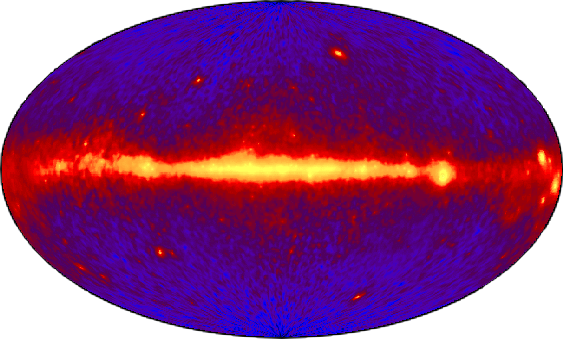Cosmic rays can mess with your power devices as well
April 14, 2017
on
on

As an electronics engineer, it is easy to imagine that tiny cosmic particles of all kinds could cause significant problems for microelectronic memories and controllers as the size of the fabrication node gets ever smaller (currently 14 nm). Interaction of these particles with the surface of the chip can in the worse case, flip the logic state of a memory cell. This is less of a problem on Earth but aboard the ISS and on space probes can cause problems for electronic systems. Shielding from cosmic radiation is hardly possible or only with disproportionate effort. The sensitivity of microelectronics has for a long time now made it necessary that the chip’s encapsulation material must be free of radioactive isotopes. Elektor has already reported on the problem.

Universal background radiation. Source: NASA.
The fact that tiny structures are more susceptible to these foreign particles makes sense and corresponds with our understanding of the physics involved. What about the much larger power electronic devices? Here we are looking at silicon conduction paths with dimensions in the range of mm³ - by semiconductor standards you wouldn’t call that tiny by any stretch of the imagination. Modern IGBTs and power MOSFETs are continually pushing the boundaries and switching more and more power. Now we can find devices with breakdown thresholds up to 1.5 kV and current ratings of hundreds of amperes. In contrast to microelectronics, power semiconductors are the rugby players of electronic components, surely those tiny particles aren’t going to cause them any trouble?

Take the output driver stage for a motor for example, here you will generally see one or more half-bridges connected in a push-pull configuration. Naturally only one half of the bridge is allowed to conduct at any time. With the transistors operating close to their maximum breakdown it could be that some wayward charged particle, emanating from who knows where, could impinge on the junction and cause the transistor to conduct for a very short time. If by chance the other transistor in the output push-pull arrangement happens to be conducting at this point the supply will effectively be short-circuited through the two conducting transistors. What follows will most likely be shrouded in smoke and accompanied by loud popping sounds, you can be sure this will be the last time the transistor switches. This chain of events is not just a theoretical possibility but has in fact been demonstrated in many laboratories with test circuits as shown on the right-hand side of the circuit diagram. In the case of exposure to high-energy radiation, it was found that failures are not rare. Other researchers came to the conclusion that IGBTs are even more sensitive than MOSFETs.
What steps can we take? On the earth's surface this is not really too much of a problem and on the top of Mount Everest there probably aren’t too many motor driver circuits or switching controllers etc. with very large power in operation. For airborne platforms (i.e. aircraft) however the problem becomes more severe. Commercial airliners travelling at an altitude of 33,000 feet experience significantly higher levels of extra terrestrial radiation. When we are told that gas turbine technology will soon be old hat and electric motors will be powering commercial airliners it starts to sound just a little worrying. The speculated manned Mars missions will require the electronics to run reliably for very many months in hostile electrical environments and it all starts to get life-threateningly serious. We can’t do much to turn off these particles at source but we sure need to get better at mitigating their influence in safety-critical applications.

Universal background radiation. Source: NASA.
The fact that tiny structures are more susceptible to these foreign particles makes sense and corresponds with our understanding of the physics involved. What about the much larger power electronic devices? Here we are looking at silicon conduction paths with dimensions in the range of mm³ - by semiconductor standards you wouldn’t call that tiny by any stretch of the imagination. Modern IGBTs and power MOSFETs are continually pushing the boundaries and switching more and more power. Now we can find devices with breakdown thresholds up to 1.5 kV and current ratings of hundreds of amperes. In contrast to microelectronics, power semiconductors are the rugby players of electronic components, surely those tiny particles aren’t going to cause them any trouble?

Take the output driver stage for a motor for example, here you will generally see one or more half-bridges connected in a push-pull configuration. Naturally only one half of the bridge is allowed to conduct at any time. With the transistors operating close to their maximum breakdown it could be that some wayward charged particle, emanating from who knows where, could impinge on the junction and cause the transistor to conduct for a very short time. If by chance the other transistor in the output push-pull arrangement happens to be conducting at this point the supply will effectively be short-circuited through the two conducting transistors. What follows will most likely be shrouded in smoke and accompanied by loud popping sounds, you can be sure this will be the last time the transistor switches. This chain of events is not just a theoretical possibility but has in fact been demonstrated in many laboratories with test circuits as shown on the right-hand side of the circuit diagram. In the case of exposure to high-energy radiation, it was found that failures are not rare. Other researchers came to the conclusion that IGBTs are even more sensitive than MOSFETs.
What steps can we take? On the earth's surface this is not really too much of a problem and on the top of Mount Everest there probably aren’t too many motor driver circuits or switching controllers etc. with very large power in operation. For airborne platforms (i.e. aircraft) however the problem becomes more severe. Commercial airliners travelling at an altitude of 33,000 feet experience significantly higher levels of extra terrestrial radiation. When we are told that gas turbine technology will soon be old hat and electric motors will be powering commercial airliners it starts to sound just a little worrying. The speculated manned Mars missions will require the electronics to run reliably for very many months in hostile electrical environments and it all starts to get life-threateningly serious. We can’t do much to turn off these particles at source but we sure need to get better at mitigating their influence in safety-critical applications.
Read full article
Hide full article


Discussion (0 comments)